LAZNIA 1 2009 - UNDER THE BRIDGE- GDAŃSK Eight artistic interventions in the public space of Gdańsk and Liverpool
05.10.2009
Artists:
Liverpool – Gdańsk: Dorota Buczkowska, Roman Dziadkiewicz, Elżbieta Jabłońska, Łukasz Jastrubczak
Gdańsk – Dolne Miasto: Ross Dalziel, Kevin Hunt, Meave Rendle, Rita Slater.
Curators: Agnieszka Kulazińska, Kevin Hunt, Rita Slater
Project “Under the bridge” results from a reciprocal exchange with partner organisations, artists and curators in Gdansk, Poland. It Originally developed as a part of For The Likes Of Us... an exchange programme between the Liverpool Biennial Big Table partners and 'corresponding' organisations across Europe, contributing towards the objectives of the Cities on the Edge network. Under the bridge is within the framework of Polish Year in Great Britain.
"Under the bridge" is supported by the Ministry of Culture and National Heritage of Republic of Poland.
Under the bridge
Eight artistic interventions in the public space of Liverpool
May-October 2009
Artists:
Liverpool – Gdańsk: Dorota Buczkowska, Roman Dziadkiewicz, Elżbieta Jabłońska, Łukasz Jastrubczak
Gdańsk – Dolne Miasto: Ross Dalziel, Kevin Hunt, Maeve Rendle, Rita Slater.
Curators: Agnieszka Kulazińska, Kevin Hunt, Rita Slater
Project “Under the bridge” originally developed as a part of “For The Likes Of Us...” an exchange programme between the Liverpool Biennial Big Table partners and 'corresponding' organisations across Europe, contributing towards the objectives of the Cities on the Edge network.
Under the bridge is within the framework of Polish Year in Great Britain.
“Under the bridge” is supported by the Ministry of Culture and National Heritage of Republic of Poland.
Roads in the city space have a specific position – they are inside the city but at the same time they are outside it. They form the “living blood circulation” of a metropolis which is every day fuelled by thousands of incomers, and they constitute part of the city infrastructure. The word, infrastructure, is composed of two Latin words – infra and structura. The first one means “below” while the other means “a set” and a certain mutual relation between elements. Infrastructure is subordinated in its supporting function for production and consumption. What is then the position of a human in this set-up? Can there be more unfriendly space in a city than the space of dual carriageways, flyovers and bridges?
The starting point for the “Under the bridge” project is a space of two bridges – over Church Road in Garston, a suburban part of Liverpool, and in Gdansk over Szopy Street. What do they have in common? They are quite remote to each other in physical space.
The bridge in Garston was established in 1980 as part of a road leading to the centre of Liverpool. Its construction, once complete, changed the image of the district. The flyover has cut Garston, a “living urban body”, into two clearly separate parts. The part located close to the port changed from a typical English suburb into a moonscape, subject to constant transformation – the old houses are slowly being pulled down and replaced by new ones, and the area is undergoing intensive revitalisation.
Gdańsk bridge over Szopy Street is part of Podwale Przedmiejskie – a high speed road designed there during the Second World War. It divided Lower Town (Dolne Miasto) from the rest of Gdańsk, thus cementing the division into a historic part and a “poor” industrial part of the city.
A simple decision of city planners had a dramatic impact on the micro scale. Both bridges have become a border line, a space in between – a symbolic passage or transition between two incompatible worlds. As under a magnifying glass the two bridges show the problems of the districts. Having crossed the border line you feel as if teleported – you are suddenly transferred into a completely different space in time. In what way do the divisions made by the bridges influence the perception of space? What impact do they have on the consciousness of local people and of visitors?
“Under the bridge” is about the series of artistic interventions in the public and “mental” space of two bridges, and seeks to analyse the subconscious of the district, symbolically linking two spaces. Can art for at least a short while eliminate the ugliness of the two bridges? Will their oppressiveness disappear for a moment?
The artistic interventions will take place once a month. We have intentionally chosen to move away from the festival form for the benefit of long-term activities. Will such form have a stronger impact on the inhabitants? The “Under the bridge” project questions the role of art and artists in public space. Are they capable of influencing society? Are their ambitions nothing but utopia, or maybe just another fashionable trend of contemporary art? What is the place of man in the art infrastructure?
ROSS DALZIEL, Bliskie spotkania
29 August 2009, godz. 5.00 – 6.00 p.m
Place: Nowa Motława i Śluza Kamienna (Fortyfikacje Miejskie in Dolne Miesto)
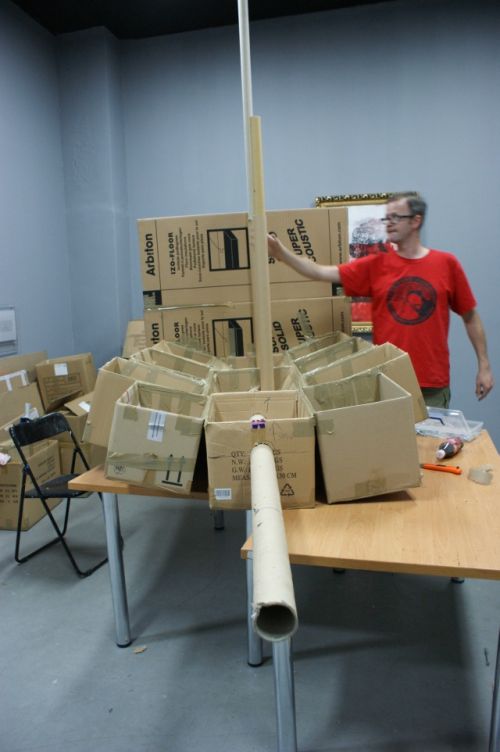
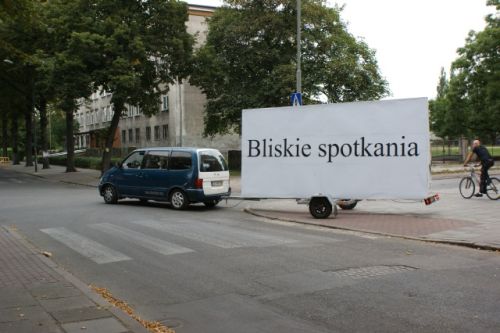
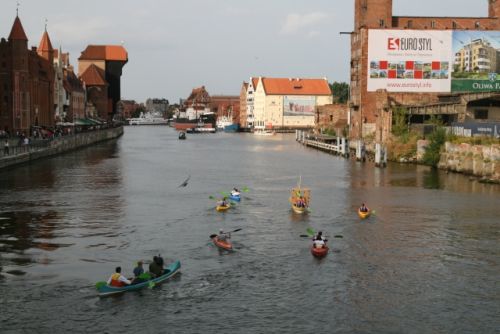
Ross Dalziel lives and works in Liverpool, and is active mainly in the area of searching for sound and new media. His works exceed the borderlines of the traditional art disciplines; they are open for co-operation and interactions with the recipients. As a curator, Dalziel is developing a programme of exhibitions based on searching for new media with a special focus on sound. The projects often take the form of workshops, installations where the recipients, by playing, compose a new piece of music or contribute to an installation. He has worked together with, among others: FACT's Collaboration Programme, MITES, Artists and Education, Creative Partnerships, Arup, Urban Design Group, Knowsley and Halton Borough Councils and many schools in the UK. You can read more about it at the website: www.cheapjack.org.uk
Ross Dalziel describes his project by referring to the exhibition of Inti Guerroro “Gestures of Entropy”. The title may be translated as unordered gestures, spontaneous signs of individual human stories made on the anonymous, ordered structures of contemporary cities. They contribute chaos and unpredictability, and thus they contribute freedom to the architectonic structures.
What makes an image of contemporary cities? Micro or macro stories? Tiny local stories, local myths or Great Narrations – ideologies looking at us from the surrounding buildings?
What story did the artist find in the Gdańsk bridge linking Dolne and Stare Miasto (Lower City and Old City)? In his work the bridge is more like a barrier than a link. It is a barrier not only in the architectonic sense but also in an economic perspective. Dolne Miasto is not one of the tourist attractions for the numerous organised groups visiting Gdańsk. Główne Miasto (the Main City) attracts tourists while Dolne Miasto is perceived as a bad neighbourhood. The artist, in his activity, makes attempts to break the barrier by referring to tiny human gestures of entropy noticed in the city structure. He uses a reconstructed galleon anchored on Motlava River, kayaks, mobile advertisements. The galleon, renewed history, will never sail to Dolne Miasto; it moves on the historic, also reconstructed part of Gdańsk. It is a popular place for stag nights for young Brits. The kayaks may be associated with the Kayak Club situated in Dolne Miasto; they are somehow naturally grown in the city district. Are we right in claiming that they are something more native, more genuine?
Ross Dalziel, by his action, is trying to create an impossible situation, to get the galleon to Dolne Miasto, to invoke the situation of a “River Festival” taking place between the Old and Lower City. His project is about architectonic barriers, cultural differences and universality, and the popularity of fake history which is a lure to visitors.
Rita Maria Slater, Guerrilla Karaoke
7-13 September 2009
Sound installation in the public space

Rita Maria Slater is interested in human relations – how they are built, including with art. In her sculptures, the artist uses ready elements – a table, typical for many English houses, two cheap but apparently luxurious chairs stuck into the table. A discreet change reveals hidden stories.
The artist is also interested in the human voice – its social meaning. What is it? A part of ourselves, something exterior or interior against our conscious ego? Its status is not explicit, unambiguous; our voice is in us but it simultaneously goes beyond our body, it completes our image in the eyes of others. It is easy to describe in a physiological perspective – the vibrations made by human vocal cords. Its social function is however more difficult to define. The voice, incoherent vocalisations, were the primeval way of communication before speech developed. The tone of the voice suggests our emotional state, reveals our opinion: remorse, sorrow, irony, indifference. We cry whenever we feel approaching danger. We sing when we want to express joy and sadness. Our voice is often our biggest enemy; it gives us away, it lets us down, and by breaking it reveals our emotions. In the perspective of feeling it makes us naked, defenceless.
The Guerrilla Karaoke Project will have the form of an audio event. A group of people will meet under the bridge to sing some jointly selected songs. The defencelessness of their voices will be confronted with the oppressiveness of the concrete architecture. For a while, the unoccupied space will be inhabited by the human voice, which will make use of the acoustics of the bridge. The voice will reverse the function of the bridge; the space in between will be the place of a mysterious meeting, will witness the creative process, building of relations, and temporary shelter from the eyes of other people. May the space be regained by the volatile, vocal guerrilla act; may the space regain its lost human dimension?
Slater’s works may be associated with the activities of a Scottish artist, Susan Philipsz. The artists are different in their different way of understanding voice. Rita Slater is not interested in cultural connotations of lyrics, in interpretations, subjectivism. The joint singing is to her an attempt to reach another human being, to communicate beyond the language barrier and ambiguity or words.
Rita Maria Slater graduated from the John Moores University in Liverpool (1999-2002), and continued her studies at the Metropolitan University in Manchester (2003-2005). She has presented her works mainly at collective exhibitions: Liverpool Biennale Independents, October 2004, Recent Work, Apartment Manchester, May 2005; Rita Slater and Jenny Dooley, Slaughterhouse Gallery, Liverpool, June 2006, Pink, Novas CUC, Liverpool, June 2008. As a curator she was involved in the Garston Cultural Village. She lives and works in Liverpool.
Maeve Rendle
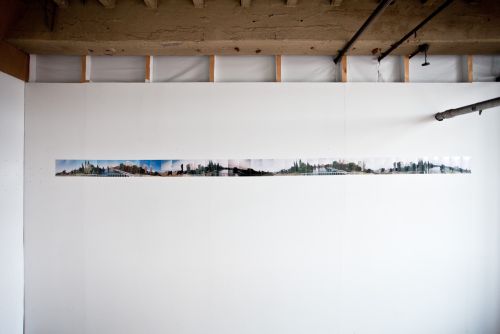
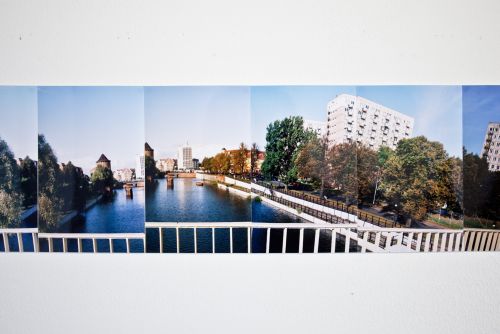
Maeve Rendle graduated from Manchester Metropolitan University (MA Fine Art 2004). She has had the opportunity to present her art in exhibitions in London, Liverpool. Manchetser, Berlin, Helsinki. She lives and works in Manchester.
The way in which Maeve Rendle works results from thinking about sculpture but the final work seems faraway of it. “I work with objects readily available, from and in any given environment. The ‘work’ comes from the potential for the object to be of interest both in and outside of its own means. What begins as a curious investigation into any part of anything, ends in a gradual manipulation to reveal a physical difference or potential within the object. It is photographed at every stage of this manipulation which acts simultaneously as an aid to the creation of, and relief from logic and reason. The sequence of photographs presented once the action has concluded, often constructs a narrative from a language seemingly foreign to the object in its original form.
Rendle invites viewers to take part in her voyages of discovery of the objects, the investigation of the possibilities which develops in time and space.
“In my practice the working process is the work itself. The process is synonymous with the work in progress. The idea belongs to and can be understood as sculpture. The process stops with the presentation of the photographs, rather than the conclusion of the process itself.
By photographing the sculpture as it is being made I trace and record actions, causes and effects. My relationship with the sculpture spatially and the duration of time spent working on and around it is made evident.
I take the photographs with a manual 35mm SLR camera. The camera is old and functions unpredictably. It retains and relinquishes control of the film advance mechanism in an intermittent fashion. The camera’s mechanical faults randomly intervene and change the resulting sequence of photographs. I can direct the work instinctively but can never predict the outcome.”
Kevin Hunt graduated from North Wales School of Art and Design (2002-2005) and Liverpool Community College (2001-2002). He makes sculptures. He took part in numerous group exhibitions, some of them were: 2008 – If You Build it they will come, g 39 Cardiff; Touching Art Touching You, Permanent Collection, Catmose, Oakham; BlindArt, Sens & Sensuality, Bankside Gallery, London; Surface, Young Curators 2006, Oriel davis Gallery, Newtown; ReNew06: A Collaboration, Hope Street Gallery, John Moores University Liverpool. In 2008 he made in collaboration with Stephen Forge “Maze” which was part of Michael Trainor`s “Garston Embassy” that developed as a part of Liverpool Biennial project. Kevin Hunt works also as a curator and is one of directors of The Royal Standard, an artist led gallery, project space and social workspace in Liverpool. He lives and works in Liverpool.
“I make sculpture using found, redundant objects which are reconfigured into something new through an act that may at times be premeditated but regularly turns out to be more casual, allowing for serendipitous and chance happenings. The objects used are often rendered functionless by the act of beautification or their function is shifted in some way, eradicating any original purpose whilst exposing an inherent aesthetic or beauty that has always lay within.”
Kevin Hunt






 BIP
BIP